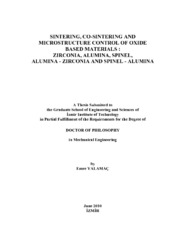Please use this identifier to cite or link to this item:
https://hdl.handle.net/11147/2879Full metadata record
| DC Field | Value | Language |
|---|---|---|
| dc.contributor.advisor | Akkurt, Sedat | en |
| dc.contributor.author | Yalamaç, Emre | - |
| dc.date.accessioned | 2014-07-22T13:48:32Z | - |
| dc.date.available | 2014-07-22T13:48:32Z | - |
| dc.date.issued | 2010 | en |
| dc.identifier.uri | http://hdl.handle.net/11147/2879 | - |
| dc.description | Thesis (Doctoral)--Izmir Institute of Technology, Mechanical Engineering, Izmir, 2010 | en |
| dc.description | Includes bibliographical references (leaves: 148-157) | en |
| dc.description | Text in English; Abstract: Turkish and English | en |
| dc.description | xxi, 157 leaves | en |
| dc.description.abstract | Densification and microstructural evolution during co-sintering of alumina (Al2O3) . zirconia (Y-ZrO2) and alumina . spinel (MgAl2O4) co-pressed bimaterials were investigated. First high purity submicron powders of monomaterials of alumina, spinel and zirconia were pressed at 100 to 250 MPa with different dry pressing techniques like UP (uniaxial pressing) and CIP (cold isostatic pressing). The latter was found to provide higher green densities. Before co-sintering of bi-materials, sintering behaviors of their end-members were studied by vertical dilatometer to determine the degree of shrinkage mismatches between the end-members. The effects of precoarsening and two-step sintering on the densification and microstructure of spinel ceramics were tested. Samples were etched both chemically and thermally to better understand their structure. Crack-free bonds were observed in alumina-spinel bi-materials after compaction by UP+CIP. Interfaces between alumina and spinel after treatment at 1400-1500 C were investigated by SEM, EDS, WDS, EBSD. A spinel interlayer with columnar grains of up to 40 .m length and 5 .m width was observed after 16 hours at 1500 C. Growth rate of this interlayer from spinel toward alumina was found to follow parabolic kinetics, controlled by a diffusion mechanism of probably lattice diffusion of O2- ions. Two isothermal steps co-sintering at 1400 C and 1500 C on the interlayer formation was tested. Two separate areas formed in the interlayer spinel. Diffusion couple tests of spinel and alumina produced the same columnar spinel grains at the interface with the same kinetics as in co-sintering experiments. Phase boundaries between the columnar spinel and alumina grains had a characteristic center of curvature located in alumina which was further indication of the direction of growth of the interlayer. | en |
| dc.language.iso | en | en_US |
| dc.publisher | Izmir Institute of Technology | en |
| dc.rights | info:eu-repo/semantics/openAccess | en_US |
| dc.subject.lcsh | Sintering | en |
| dc.subject.lcsh | Microstructure | en |
| dc.subject.lcsh | Zirconium oxide | en |
| dc.subject.lcsh | Zirconium alloys | en |
| dc.subject.lcsh | Aluminum oxide | en |
| dc.subject.lcsh | Spinel | en |
| dc.title | Sintering, co-sintering and microstructure control of oxide based materials: Zirconia, alumina, spinel, alumina-zirconia and spinel-alumina | en_US |
| dc.type | Doctoral Thesis | en_US |
| dc.department | Thesis (Doctoral)--İzmir Institute of Technology, Mechanical Engineering | en_US |
| dc.relation.publicationcategory | Tez | en_US |
| item.openairecristype | http://purl.org/coar/resource_type/c_18cf | - |
| item.languageiso639-1 | en | - |
| item.cerifentitytype | Publications | - |
| item.grantfulltext | open | - |
| item.openairetype | Doctoral Thesis | - |
| item.fulltext | With Fulltext | - |
| Appears in Collections: | Phd Degree / Doktora | |
Files in This Item:
| File | Description | Size | Format | |
|---|---|---|---|---|
| T000168.pdf | DoctoralThesis | 29.53 MB | Adobe PDF |  View/Open |
CORE Recommender
Page view(s)
202
checked on Oct 28, 2024
Download(s)
142
checked on Oct 28, 2024
Google ScholarTM
Check
Items in GCRIS Repository are protected by copyright, with all rights reserved, unless otherwise indicated.